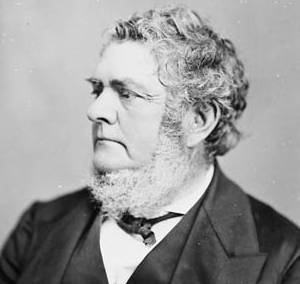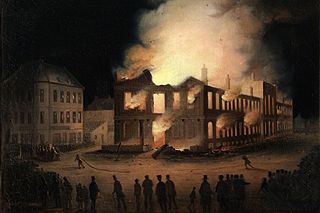There are currently fourteen legislative buildings in Canada: Parliament in Ottawa, and one for each of the provinces and territories of Canada, though not all contain the words legislative building in their names.

The Province of Canada was a British colony in British North America from 1841 to 1867. Its formation reflected recommendations made by John Lambton, 1st Earl of Durham, in the Report on the Affairs of British North America following the Rebellions of 1837–1838.

The Province of Upper Canada was a part of British Canada established in 1791 by the Kingdom of Great Britain, to govern the central third of the lands in British North America, formerly part of the Province of Quebec since 1763. Upper Canada included all of modern-day Southern Ontario and all those areas of Northern Ontario in the Pays d'en Haut which had formed part of New France, essentially the watersheds of the Ottawa River or Lakes Huron and Superior, excluding any lands within the watershed of Hudson Bay. The "upper" prefix in the name reflects its geographic position along the Great Lakes, mostly above the headwaters of the Saint Lawrence River, contrasted with Lower Canada to the northeast.

The Province of Lower Canada was a British colony on the lower Saint Lawrence River and the shores of the Gulf of Saint Lawrence (1791–1841). It covered the southern portion of the current Province of Quebec and the Labrador region of the current Province of Newfoundland and Labrador.

The Canadas is the collective name for the provinces of Lower Canada and Upper Canada, two historical British colonies in present-day Canada. The two colonies were formed in 1791, when the British Parliament passed the Constitutional Act, splitting the colonial Province of Quebec into two separate colonies. The Ottawa River formed the border between Lower and Upper Canada.

The Constitutional Act 1791 was an Act of the Parliament of Great Britain which was passed during the reign of George III. The act divided the old Province of Quebec into Lower Canada and Upper Canada, each with its own parliament and government. It repealed the Quebec Act 1774. The act remained in force until 1841, when it was largely repealed by the Union Act, 1840, which reunited the two provinces into the new Province of Canada. Some provisions relating to the clergy reserves remained in force. The remaining provisions of the act were repealed over time, with final repeal in 1966.

The Province of Quebec was a colony in British North America which comprised the former French colony of Canada. It was established by the Kingdom of Great Britain in 1763, following the conquest of New France by British forces during the Seven Years' War. As part of the 1763 Treaty of Paris, France gave up its claim to the colony; it instead negotiated to keep the small profitable island of Guadeloupe.

John Neilson was a journalist, publisher and politician in Lower Canada. Born in Scotland, he emigrated to Lower Canada in 1791 at age 15, to work in his older brother's publishing company in Quebec City. On his brother's death a few years later, he inherited the business. Neilson became one of the leading publishers and booksellers in Lower Canada and in Upper Canada, selling books in both French and English. He was the editor of the newspaper La Gazette de Québec / The Quebec Gazette, published in French and in English.

Western District was one of four districts of the Province of Quebec created in 1788 in the western reaches of the Montreal District which were later detached in 1791 to create the new colony of Upper Canada. Known as Hesse District until 1792, it was abolished in 1849.

Midland District was one of four districts of the Province of Quebec created in 1788 in the western reaches of the Montreal District and partitioned in 1791 to create the new colony of Upper Canada.

The Legislative Council of Upper Canada was the upper house governing the province of Upper Canada. Modelled after the British House of Lords, it was created by the Constitutional Act of 1791. It was specified that the council should consist of at least seven members. Members were appointed for life but could be dropped for non-attendance. The first nine members of the council were appointed on 12 July 1792. The speaker was usually the Chief Justice of the Court of King's Bench. The Legislative Council was dissolved on 10 February 1841 when Upper and Lower Canada were united into the Province of Canada. Some members were reappointed to the Legislative Council of the united Province.
The Legislative Assembly of the Province of Canada was the lower house of the Parliament of the Province of Canada. The Province of Canada consisted of the former province of Lower Canada, then known as Canada East, and Upper Canada, then known as Canada West. It was created by The Union Act, 1840.

Robert Christie was a lawyer, journalist, historian and political figure in Lower Canada and Canada East. Born in Nova Scotia, he moved to Lower Canada as a young man. Elected to the Legislative Assembly of Lower Canada, he generally supported the Parti bureaucrates, or government group. He opposed the union of Lower Canada with Upper Canada, but was elected to the Legislative Assembly of the Province of Canada. As a member, he remained opposed to the union and was an independent, not supporting any particular party. He had a reputation for being hot-headed, but also incorruptible.
The 3rd Parliament of the Province of Canada was summoned in 1848, following the general election for the Legislative Assembly in January 1848. The first session was held at Montreal, Canada East. In 1849, rioters protesting the Rebellion Losses Bill burned the parliament buildings. The remaining sessions were held in Toronto. The Parliament was dissolved on November 6, 1851.
The Legislative Council of the Province of Canada was the upper house for the Province of Canada, which consisted of the former provinces of Lower Canada, then known as Canada East and later the province of Quebec, and Upper Canada, then known as Canada West and later the province of Ontario. It was created by The Union Act of 1840. With the lower house, the Legislative Assembly of the Province of Canada, the two houses constituted the Parliament of the Province of Canada.

Malcolm Cameron was a Canadian businessman and politician.

Old Parliament Building (Quebec) was the site of the seat of government of Lower Canada (1791-1833), Canada West, Province of Canada and Quebec (1867-1883).
The Executive Council of the Province of Canada had a similar function to the Cabinet in England but was not responsible to the Legislative Assembly of the Province of Canada from its inception in 1841 to 1848.

The burning of the Parliament Buildings in Montreal was an important event in pre-Confederation Canadian history and occurred on the night of April 25, 1849, in Montreal, the then-capital of the Province of Canada. It is considered a crucial moment in the development of the Canadian democratic tradition, largely as a consequence of how the matter was dealt with by then co-prime ministers of the united Province of Canada, Sir Louis-Hippolyte Lafontaine and Robert Baldwin.
Two Mountains was an electoral district of the Legislative Assembly of the Province of Canada, Canada East, in a rural area north-west of Montreal. It was created in 1841, based on the previous electoral district of the same name for the Legislative Assembly of Lower Canada.

Section 68 of the Constitution Act, 1867 is a provision of the Constitution of Canada relating to the seats of government of the four original provinces, New Brunswick, Nova Scotia, Ontario and Quebec.